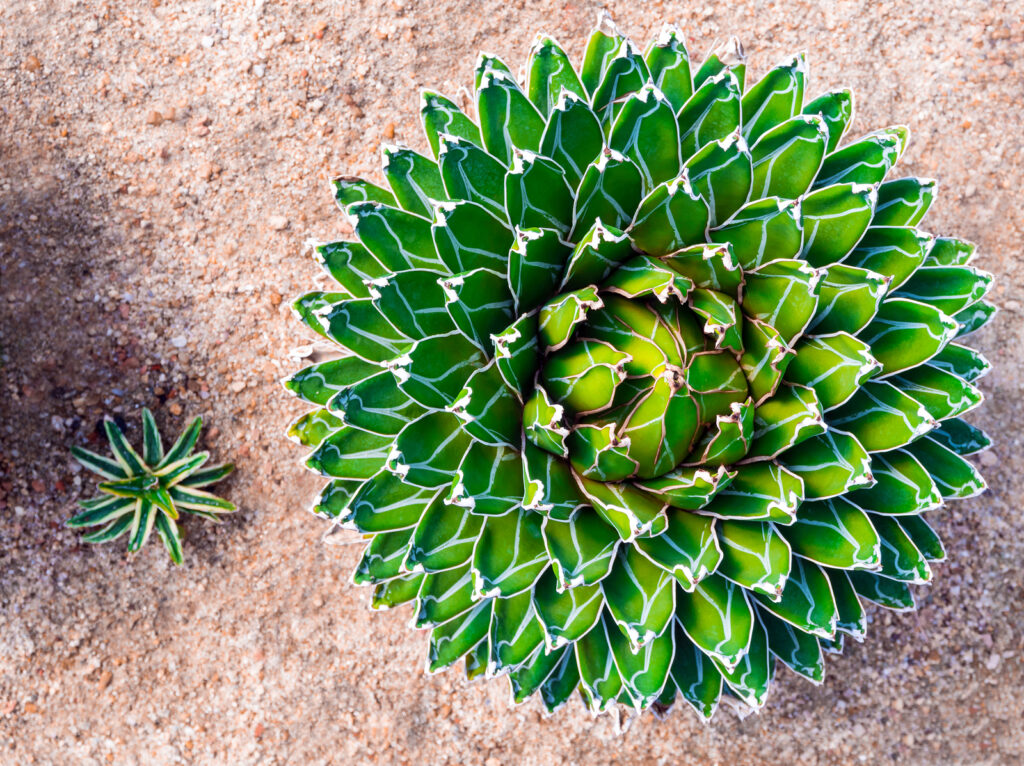Agave is an evergreen perennial with rosettes of lance-shaped sharply pointed gray-green leaves and blooms on tall stems. Mature plants bear cream-colored flowers. Plants grow 14 to 36 inches (35-91cm) tall.
Agave is a genus containing many species of handsome plants with long, stiff, evergreen leaves forming clumps or rosettes from which rise the tall, bare flower stems. Leaves often have teeth or threadlike fibers along the edges and sharp spines at the tips. They belong to the Amaryllis Family and are natives to warm arid and semi-arid regions of America.
Some Agave bloom annually, but most of them at much longer intervals, and some species die after blooming. The common name “century plant” is a misnomer; agave usually takes only 10 years to flower, but sometimes up to 50 years. Agave rarely blooms when grown indoors.
In hot summer regions, Agaves are planted as lawn specimens or about the foundation of houses. The species Agave americana is common as a house or porch plant in cool summer regions. In cold winter regions, grow Agave in a pot and overwinter it indoors.
Agaves are variously propagated–by seed, from the bulbels formed in the flowers clusters, from suckers, or by underground stems. The soil should be a mixture of sand and loam and thoroughly drained.
The Agave genus contains more than 300 species of succulents.
Get to know Agave
- Plant type: Houseplant and outdoors in warm-winter regions
- Growing Zones and range: 8-11
- Hardiness: Desert native
- Optimal growing temperature: day, 68° to 80°F (20° to 27°C); night, 50° to 70°F (10° to 21°C).
- Height and width: To 4 feet (1.2m) tall and wide
- Foliage: Blue-gray or silvery leaves are narrow with spiny edges
- Form: Rosette of sharp, long, upright foliage; long, pointed, sharp leaves with pointed ends; plant takes on a candelabra form
- Flowers: Cream-colored blooms on tall spikes; called century plant because it is mistakenly thought to bloom every 100 years; it blooms every 15 to 20 years, occasionally more often.
- Bloom time: Every 5 to 20 years
- Uses: Houseplant, desert gardens
- Common name: Century plant
- Botanical name: Agave spp.; Agave americana
- Family: Agavaceae
- Origin: The Americas
Where to plant Agave
- Agave needs high light with full sun.
- Indoors grow Agave in bright, filtered sun from southern, southeastern, or eastern exposure. Fresh air circulation is important.
- Grow Agave in average room temperature.
- GrowAgave in a mix of sand and soil; add a pinch of ground limestone to the mix.
When to plant Agave
- Set Agave outdoors in spring or fall; grow indoors at any time.

Planting and spacing Agave
- Agave grows to 4 feet tall and wide in large containers.
- In the ground, it can grow 8 to 10 feet tall and wide.
How to water and feed Agave
- Too much water will cause agave to rot. In spring and summer, let soil dry between thorough waterings. Overwatering causes plant to rot.
- Indoors, mist daily around the plant, not directly on it.
- Agave prefers humidity of 20% to 25%.
- Feed Agave every 6 weeks during growing season, with low-nitrogen, high-potassium fertilizer.
Agave plant care
- Plants like being potbound; move them to a larger container only when they have completely outgrown their pot. Pot-on when roots occupy ½ of pot space or when foliage is crowded. Best done in spring.
- Agave rests from fall to early spring. Place Agave in a cool, bright location where the plant receives 5 hours of sunlight daily. Gradually reduce water, giving just enough to keep plant from shriveling; withhold fertilizer.
Growing Agave as a houseplant
- Agave victoriae-reginae is often grown as a houseplant; it grows to 10 inches tall with dark green leaves and creamy white edges.
- Give Agave direct light, average room temperature, and low humidity.
- Water infrequently but thoroughly.
- Fertilize once a year in spring or summer.
- Use cactus mix when repotting and wear gloves for protection from the spine-tipped leaves.
- Agave rarely blooms when grown indoors.
Agave pests and diseases
- Check for aphids, mealybugs, spider mites, scale. Also, be alert for fungus disease.
Agave propagation
- Propagate Agave by suckers or seeds.
- Remove offsets from the base of the plant and pot them up to the root.
- Agave can be grown from seed taken from flowering plants.
Agave varieties to grow
- Agave americana. Grows to 5 feet (1.5 m), has yellow-edged green leaves; after 15 to 20 years the stalk bears yellow flowers.
- Agave americana ‘Marginata’ with green and yellow-edged leaves; ‘Mediopicta’ has cream leaves with green edges.
- A. desmettiana. Grows to 2 feet (60cm) wide with dark green to blue-green leaves.
- A. filifera. Grows to 10 feet (3 m) tall; its shiny green leaves are etched with white.
- A. parviflora. Grows to just 4 inches (10 cm) tall, featuring leaves similar to A. filifera.
- A. stricta. Grows to 14 inches (36 cm); has closely packed, slender, dark green leaves;
- Agave victoriae-reginae. Grows to 6 inches (15 cm) tall and 10 inches wide; has thick, blue-green leaved edged and striped in white.















